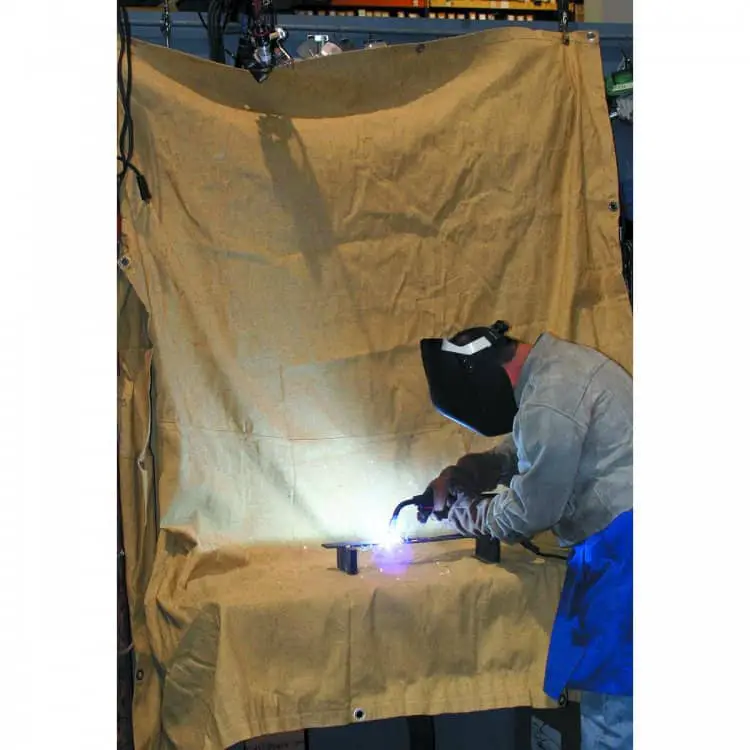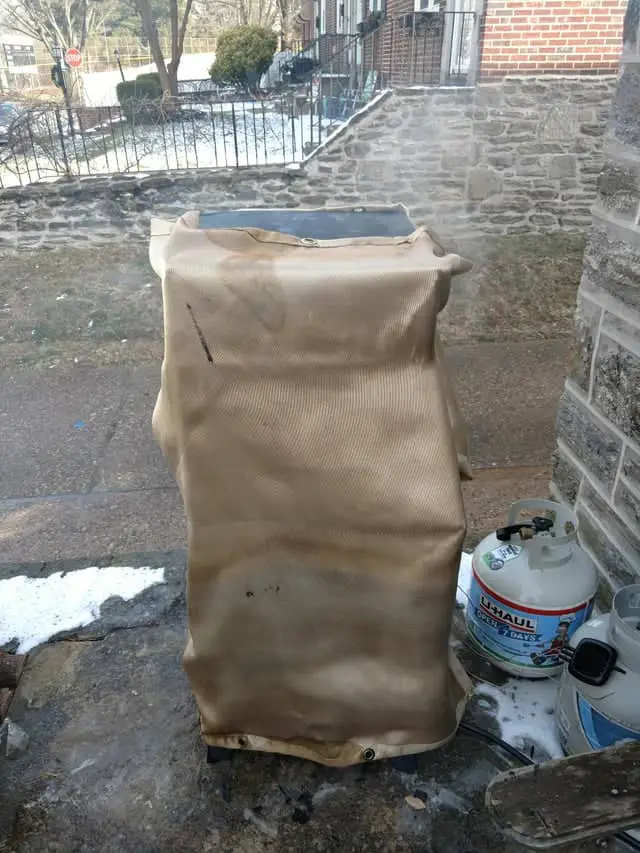This post contains affiliate links to products, services, or education. We may receive a commission for purchases made through links.

Welding blankets are used to cover up various equipment parts or even the welder themselves during the welding process. They are a great tool to have around, and I recommend them to any welder who has not yet invested in them, but there are some questions around them. Are welding blankets waterproof?
They are water-resistant, but most likely not 100% waterproof. These blankets are primarily made to be fire-resistant, and being waterproof is not exactly a welding blankets purpose. However, they tend to resist water and are not harmed by it.
Today, we’ll be taking a look at what precisely a welding blanket is, how you use it, and more.
What is a welding blanket?
Well, a welding blanket is just as it sounds. It is a blanket used for the protection of equipment and the welder under various circumstances. They are quite flexible due to the material that is used to make them, as well as being resistant to heat.
These blankets are also flame retardant, as many of the new welding blankets are infused with fiberglass. The fiberglass not only makes the blankets flexible but is the main reason as to why they are flame retardant.
Most welding blankets these days can resist temperatures of upwards of 2,500 degrees Fahrenheit, which is impressive.
Also, you can get custom made blankets to better fit your needs, which is a massive plus in my eyes. These blankets have the appearance of a tarp-like sheet and are relatively cheap as well, which we’ll be getting into in just a bit.
How Much Water Can It Resist?
There haven’t been any professional tests on how much water a welding blanket can absorb or resist. Due to it being tarp-like, we can certainly infer that water won’t harm it. Although they do not have the same properties as a tarp, the shape and thickness will do a solid job of keeping out the water relatively well.
So, if you are worried about some water getting on it, then it should be perfectly fine, and it shouldn’t be a concern. Also, if the blanket has grommets, then you should be able to tie it down as well if you want it to act as a tarp.
However, I wouldn’t be too reliant on it to be as resistant as a tarp against water as again; these are made to resist heat and fire, not water.
Prices
The prices of welding blankets indeed depend on the size and quality, but you can generally find a pretty standard one that does an excellent job for under $30. So, in terms of price being a factor as to whether you get one or not probably won’t be an issue, considering just how handy they are.
Are Welding Blankets Necessary?
Technically, a welding blanket is not a work area necessity if you are surrounded by concrete or metal. However, if you are working around carpeting, particleboard, cars, or any other delicate material, they are essential for your safety and to keep your surroundings safe. I recommend using one due to just how handy they are. They do a fantastic job of controlling sparks in addition to protecting yourself and any surrounding equipment.
So, although they are not technically a necessity, I’d say they are too good of a product to pass up. Also, as I mentioned, the blankets are rather inexpensive as well, so it seems like a no-brainer type of purchase.
Fiberglass
As I mentioned before, fiberglass is used in practically all welding blankets, which is what makes them so resistant to both heat and flames. The most common sizes these blankets come in are 4×6 and 6×8. However, as I mentioned, you can get custom-sized welding blankets as well, which is nice.
Fiberglass is also one of the most durable materials that you’ll find in these blankets.
How to Choose the Right Welding Blanket
When you first go to look for a welding blanket, the choices can be quite overwhelming. The first thing I recommend doing is assessing what you’ll need and what you think will work best for your work area.
Material
Next, I’d narrow down the material that you want. Common materials welding blankets are made of include:
- Fiberglass
- Leather
- Felt
As I mentioned earlier, the most popular material used is fiberglass and is the best one that I’d recommend. They are pretty much the universally accepted blanket to use.
However, the other materials that are used are leather and felt, which also have their perks.
Leather welding blankets have been used for a long time and work very well. If they get wet, it is best to dry them thoroughly as soon as possible. Some leather shrinks or cracks over time if exposed to excessive moisture. High heat can also take a toll if the leather is not conditioned for it. Expect to replace it sooner than fiberglass if you use it a lot, it is cheap leather, or if it is not appropriately conditioned. The highest quality leather welding blankets can also be a little more expensive than the alternatives.
Felt blankets also work nicely and can be cheaper than the alternatives. The felt sheets are very heat resistant but are not nearly as durable. It’s better than nothing, but not as effective as the alternatives, in my opinion.
I’d have to recommend that you use the fiberglass blankets. I feel they are not only the best value but also the best in terms of efficacy. Leather is a very, very close second and possible my first choice if money is not an issue.
Once you’ve decided which material you want to go with, then you can choose the type of coating that you want. Coatings include polyurethane, acrylic, neoprene, vermiculite, and silicone. Coatings are essential, especially for fiberglass welding blankets. In not correctly coated, the fiberglass will irritate your skin.
They’ve all got pros and cons and vary in price, so research that a bit before buying. If you are looking at a fiberglass blanket, I highly recommend vermiculite. It works well for light and heavy-duty welding, it does not irritate the skin, and it has a high heat tolerance.
After you’ve got these two things figured out, then the last thing to figure out is what size is best for you. When it comes to size, I recommend always going a bit larger than you think you’ll need. A larger size will ensure all surroundings are covered. Sparks can travel further than you’d expect, especially if there is a breeze present.
Temperature
Another aspect that you’ll want to make sure is correct when it comes to purchasing a welding blanket is that it can resist the heat that you need it to. These blankets vary quite a bit as to what they can endure in terms of temperature, so this is something that I’d certainly check out before the purchase.
The type of welding that you are doing will typically determine the range of temperature that you’ll be working with. If you are somewhat new to welding, I recommend doing a bit of research on the type of welding you will be doing before making your purchase.
What Other Uses Are There?

There is quite a bit of use for the welding blanket, as we’ve discussed a few already. However, there are more practices that a good welding blanket can manage as well. Besides protecting equipment and the welder, these blankets also can be useful during other processes like grinding, insulating, or anything you might do that involves heat rising or spreading from a fixed location.
Also, because of how heavy-duty the welding blankets are, many people use them as an insulation tool for when cold weather approaches. What is also good about welding blankets is because of their low price, you can always get multiple to fulfill various uses.
Overall, there are practically endless uses for a good welding tarp. This is again why I think it is such an excellent investment that comes at a reasonable price.
Welding Blanket Wrap-Up
Overall, the welding blanket is a fantastic investment for countless reasons. Not only is it going to hold off some water, (if you encounter some) but it also does a tremendous job of protecting you and surrounding equipment while working. Also, there are many other ways that welding blankets can be used as well, which makes them a no-brainer tool to have around the house.
Overall, these blankets are quite inexpensive, and you can find a great one for around $30 or less. With that type of price, especially in the welding industry where prices are usually quite high, it is one of the best investments I can recommend.
Finally, no matter where you are at in regards to your welding skills, a welding blanket will come in quite handy. Whether you are an owner of a large shop or do it on the side as a hobby, you will find good use with one. With that, I recommend them highly to anyone who is looking to do any form of welding, grinding, or cutting. Some people use them in other unorthodox ways, such as an insulation tool, a smoker insulator, and so on.
